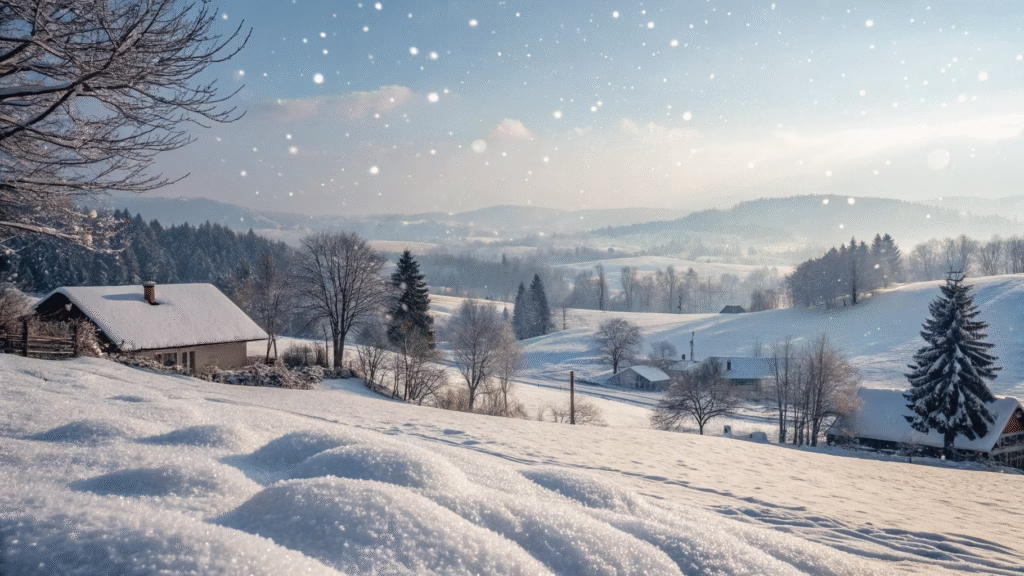
Why Snowfall Makes the World So Quiet?
Have you ever stepped outside during a snowfall and felt like the whole world suddenly went silent? Streets that normally hum with traffic, footsteps, and voices seem strangely muted. Even busy cities take on a softer, more peaceful atmosphere.
It’s not your imagination — snowfall really does make the world quieter. And there’s fascinating science behind it. From the physics of sound absorption to the emotional calm snow brings, this article explores why snow muffles sound, what’s happening on a microscopic level, and why the quiet doesn’t last forever.
To explore all of these in 3D, check out our detailed YouTube explanation linked at the end of this blog — and don’t forget to subscribe for more insightful videos! (Available in Englsh & Malayalam )
Snow and Sound: What’s Really Happening?
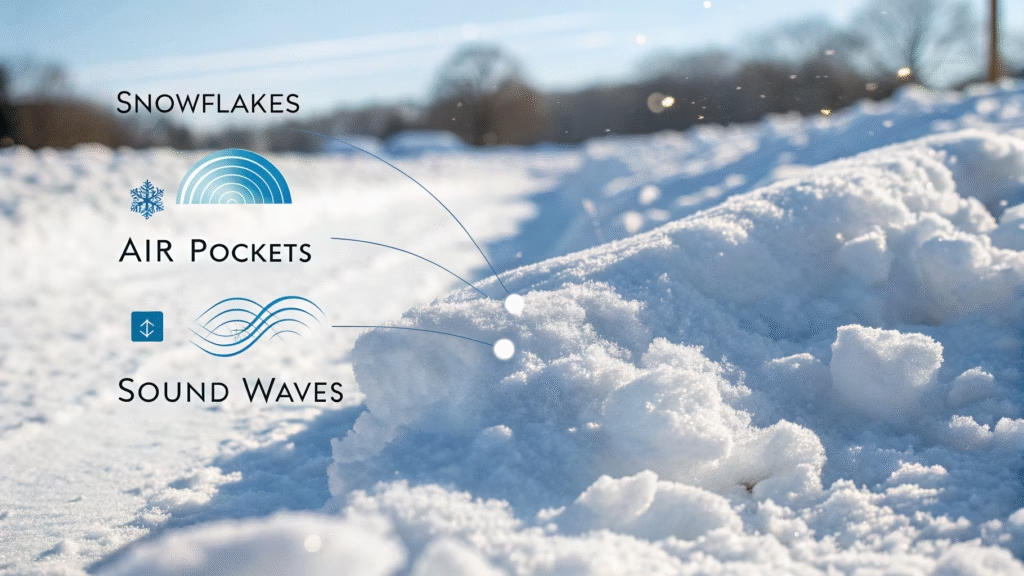
To understand why snow quiets the world, we first need to understand how sound works.
Sound travels in waves — vibrations that move through air (or other materials) until they reach our ears. When these waves hit a solid surface, they bounce, reflect, or scatter, creating echoes and noise. Hard surfaces like roads, buildings, and frozen ground reflect sound very efficiently, which is why cities and open landscapes can sound loud and lively.
Now, enter snow.
Snow’s Unique Structure
Each snowflake is a tiny, six-sided crystal of ice with an intricate, delicate structure. When billions of them fall and accumulate on the ground, they create a porous blanket of snow — a mixture of ice and air.
Fresh snow is made up of roughly 90 to 95% air trapped between crystals. These countless air pockets form a soft, fluffy layer that acts like an acoustic sponge. When sound waves hit this layer, instead of bouncing back, they get absorbed, scattered, and weakened.
This process is known as sound absorption by snow — and it’s the main reason snowfall feels so peaceful.
How Much Quieter Does It Get?

You might wonder: Is the world really quieter, or does it just seem that way?
Studies show it’s both real and measurable. Research from the U.S. National Center for Atmospheric Research (NCAR) and the University of Illinois found that a fresh layer of snow can reduce ambient sound by up to 60% — depending on snow type, depth, and surrounding conditions.
That’s like suddenly turning down the city’s background noise by more than half.
Factors That Affect Snow’s Sound Absorption
Not all snow is equally quiet. Its ability to absorb sound depends on several factors:
Fresh, powdery snow – Absorbs sound the most. The loose structure and large air gaps scatter sound waves efficiently.
Wet or compacted snow – Absorbs less. As snow melts or is walked on, the flakes stick together, reducing air space and allowing sound waves to pass more easily.
Snow depth – Thicker layers provide better sound insulation. A deep snowpack can muffle even low-frequency noises like traffic or wind.
Temperature and humidity – Cold, dry conditions help maintain snow’s fluffiness, while warm or wet weather compresses it.
So the next time you step outside during or right after a fresh snowfall and feel that serene hush — you’re experiencing a real, measurable drop in sound.
What Happens at the Microscopic Level?
The secret behind snow’s quieting power lies in physics and acoustics.
When a sound wave hits the snow surface, part of it gets reflected, but much of it enters the porous snowpack. Once inside, the wave meets countless tiny air pockets and irregular surfaces that scatter the sound energy in different directions.
This scattering process causes friction and energy loss, converting the sound wave’s energy into tiny amounts of heat. (Don’t worry — not enough to melt the snow!) The result: the sound becomes weaker, softer, and more diffuse by the time it leaves the snow layer.
This same principle is used in soundproofing materials like acoustic foam and fiberglass panels — all filled with small air pockets to trap sound waves.
In essence, snow is nature’s soundproof blanket.
Why the Quiet Doesn’t Last Forever
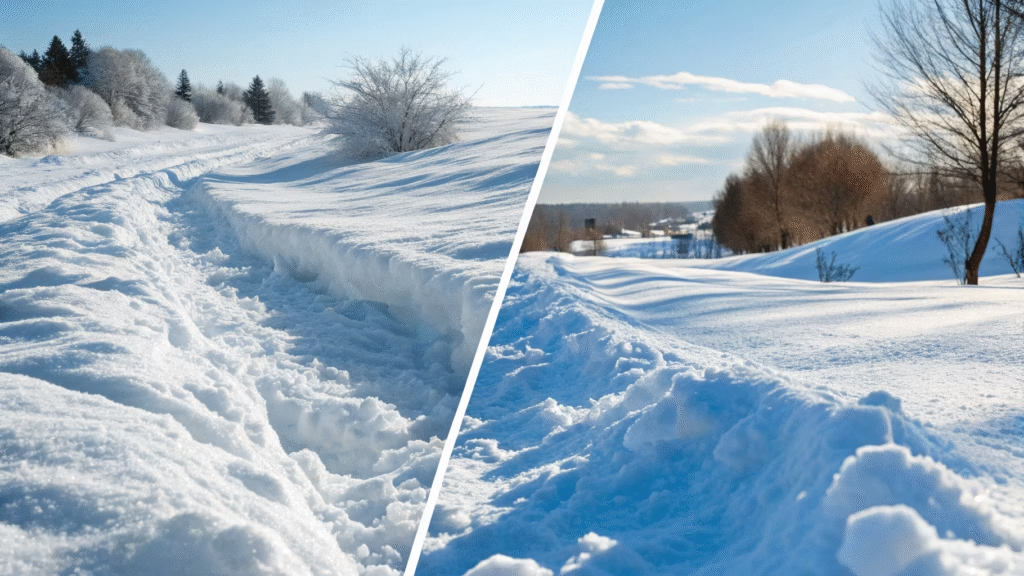
If you’ve noticed, that magical stillness doesn’t stick around for long. After a day or two, the familiar sounds of life — cars, voices, wind — seem to return.
That’s because the structure of snow changes over time.
Snow Settling and Compression
As snow sits on the ground, gravity gradually compresses the lower layers. Ice crystals fuse together, and the air pockets that once absorbed sound begin to collapse. The snow becomes denser and less porous, meaning it reflects sound instead of absorbing it.
Melting and Refreezing
Sunlight, temperature fluctuations, and foot traffic all contribute to snow compaction. When snow melts and refreezes, it forms an icy crust that behaves more like a hard surface than a soft sponge. That crust reflects sound waves — restoring normal acoustic conditions.
In short: fresh snow absorbs sound, old snow reflects it.
That’s why the quietness of a snowfall is temporary — a fleeting gift from nature that fades as the snow transforms.
Snow and Acoustics: More Than Just Silence
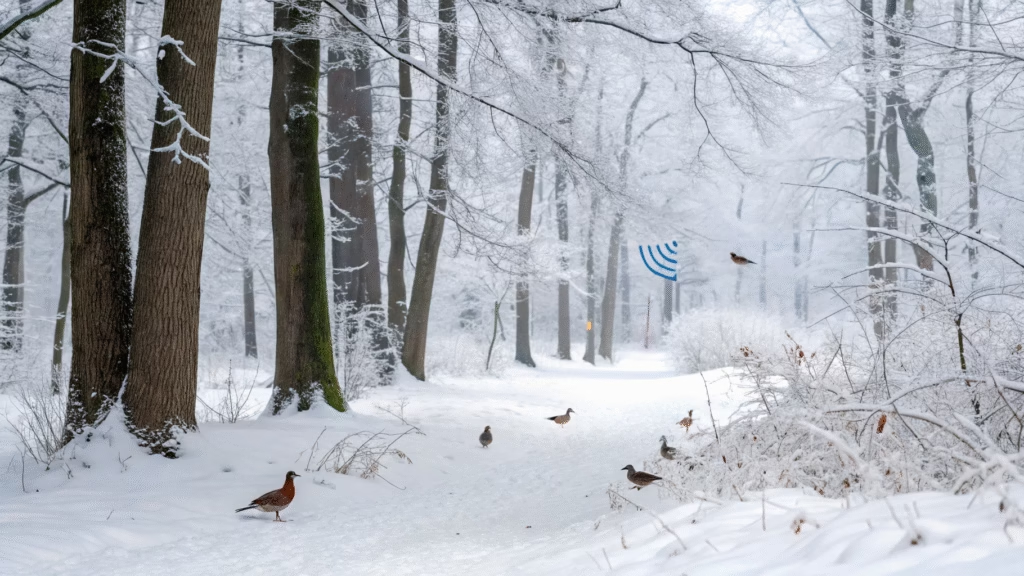
The impact of snow on acoustics goes far beyond making things “quiet.” It also affects how sound travels across distances.
The “Muffled” Effect
In snow-covered environments, sound doesn’t just get quieter — it changes character. Even noises that make it through the snow’s absorption layer sound softer and more diffuse. The crispness of footsteps, the ring of a bell, or the rumble of a car engine all seem gentler.
This is because high-frequency sounds (like chirping birds or voices) are absorbed more easily than low-frequency sounds (like wind or distant traffic). As a result, the soundscape shifts toward lower tones — giving snowy days their characteristic “hushed” atmosphere.
Snow in Forests and Mountains
In forests blanketed with snow, sound absorption becomes even more profound. The snow-covered ground, tree branches, and trunks all work together to scatter and dampen sound waves.
That’s why hikers and skiers often describe snowy forests as eerily silent — footsteps are muffled, and even the crunch of snow beneath boots sounds subdued. Wildlife biologists often note that animals appear calmer and quieter during fresh snowfalls, possibly because they, too, are affected by the altered sound environment.
Human Perception: Why We Feel the Silence
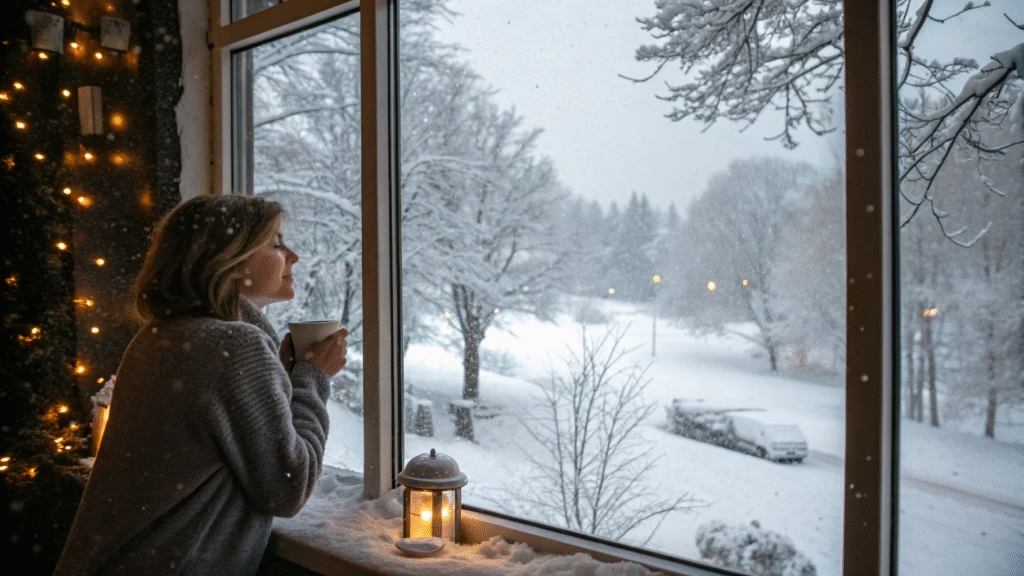
The Psychology of Quiet
Sound plays a major role in our emotional and mental state. Constant noise — traffic, chatter, construction — triggers the brain’s stress response, even if we don’t consciously notice it. When snow falls and noise levels drop, the brain interprets the environment as safer and more peaceful.
The result? Relaxation, calmness, and even a sense of awe.
Studies in environmental psychology show that lower ambient noise levels can reduce heart rate, decrease cortisol (the stress hormone), and improve mood. Add to that the visual beauty of falling snow, and it’s easy to understand why snow days feel almost magical.
“Soft Fascination” and Winter Mindfulness
According to Attention Restoration Theory (ART), natural environments that gently engage our senses — like snowy landscapes — allow our overworked brains to rest and recharge. This is known as soft fascination.
The combination of muted sounds, slower movements, and white scenery encourages mindfulness. That’s why walking in snow can feel meditative, helping people disconnect from daily stress and reconnect with nature.
Snow’s Influence on Wildlife
Humans aren’t the only ones affected by snow’s quieting power.
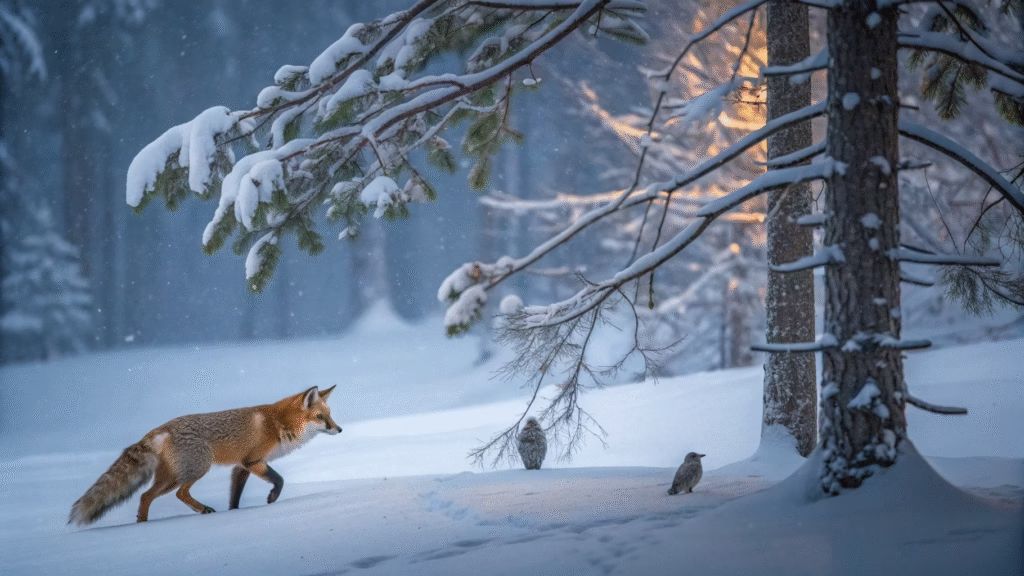
Animals and Sound in Winter
For animals, sound is crucial for communication, navigation, and detecting predators. When snow dampens sound, it changes how animals behave.
Predators like foxes and owls rely more on sight and vibration sensing when snow muffles prey movements.
Prey animals like rabbits and rodents may find temporary safety because predators can’t hear them as well.
Birds may alter their calls or move to areas with better sound transmission.
Researchers studying Arctic and alpine wildlife often note that the snow blanket creates a subnivean zone — the space between the snowpack and ground — where small mammals live in relative quiet and warmth, shielded from both noise and wind.
The Role of Temperature and Humidity
Sound doesn’t just depend on the ground — the air itself plays a big role.
In cold temperatures, air molecules move more slowly, which slightly reduces the speed of sound. Meanwhile, cold air tends to form temperature layers that can bend (or refract) sound waves upward, away from your ears. This effect, combined with snow’s absorption, contributes to the feeling of deep stillness.
Humidity also matters: drier winter air absorbs high-frequency sounds more efficiently, further softening the overall soundscape.
Together, these atmospheric conditions enhance snow’s natural quieting effect.
Snow as Natural Soundproofing: Real-World Applications
The same principles that make snowfall quiet have inspired engineers and architects.
Acoustic insulation materials — like foam panels or fiberglass — mimic the structure of snow by trapping air within porous surfaces. This design breaks up sound waves and reduces echoes, similar to how snowflakes scatter vibrations.
In fact, researchers studying arctic acoustics sometimes use snow as a model for designing better sound-absorbing materials, especially for outdoor or cold-climate environments.
Fun Facts About Snow and Silence
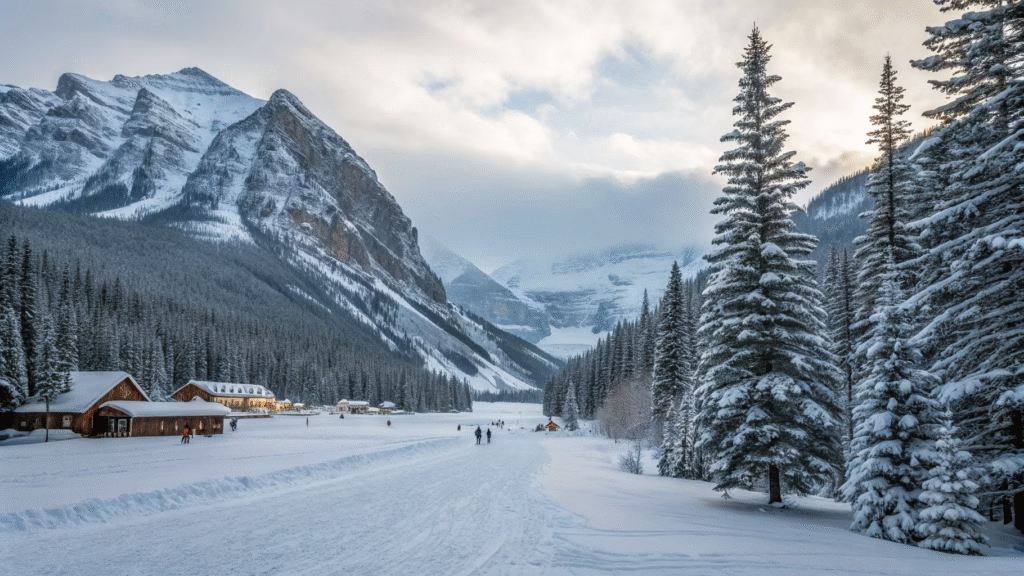
Low frequencies travel farther in snow. That’s why distant thunder or train sounds can still be heard faintly on snowy days, even when everything else seems quiet.
Fresh snow is quieter than icy snow by up to 60%. Once snow crusts over, it behaves acoustically like pavement.
Ski resorts sound peaceful for a reason. The thick snow cover and wide-open terrain reduce echoes and background noise dramatically.
Indigenous cultures recognized this effect. Many Arctic and northern tribes incorporated the silence of snowfall into myths and songs, viewing it as a spiritual pause in nature’s rhythm.
Snow affects radar and sonar too! Scientists studying how sound and electromagnetic waves move through snow have used the data to improve weather prediction and avalanche safety.
Why We Love Snow’s Silence
Part of snow’s beauty lies in how it changes not just the landscape, but the soundscape. When familiar noises fade, we become aware of subtler ones — the crunch underfoot, the rustle of wind, our own breathing.
It’s a sensory reset, reminding us of how much noise fills our daily lives. The hush of snowfall invites mindfulness — a moment to slow down, listen, and simply be.
That’s why people often describe snowy days as “peaceful,” “cozy,” or “magical.” Science explains the mechanics, but our hearts explain the feeling.
Conclusion: Nature’s Moment of Quiet

So, why does snowfall make the world so quiet?
Because snow is a natural sound absorber. Fresh, fluffy snow traps air between its flakes, creating millions of tiny pockets that scatter and weaken sound waves. This turns busy streets and forests alike into tranquil, hushed wonderlands.
But this serenity is fleeting. As snow compresses, melts, or freezes, those air pockets disappear — and with them, the magical quiet fades away.
The next time you step outside during a snowfall, take a deep breath and listen. The stillness you hear is more than just the absence of noise — it’s a brief moment where nature softens the edges of the world, wrapping everything in a blanket of peace.
Watch it in action!
Watch it in Malayalam
Want to learn more through visual storytelling? Check out our detailed 3D explanation blog on How Popcorn Became the Main Snack in Movie Theaters: From Ancient Origins to Theater Revenue Booster
Useful Link : Snow- Wikipedia
Educative 👍